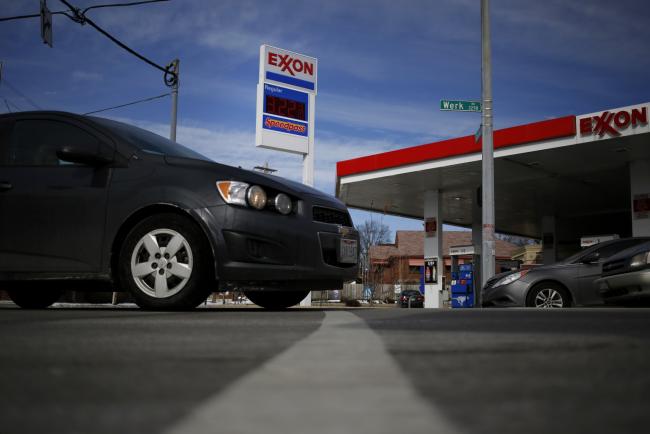(Bloomberg) -- Big Oil’s gold standard is losing some of its luster.
Exxon Mobil Corp (NYSE:XOM). basked in a premium stock valuation for two decades thanks to unparalleled financial discipline, management expertise and the ability to weather oil-price downturns that hobbled lesser rivals. Those days are over.
The world’s largest driller by market value is struggling to replace the crude it pumps each year with new findings, and has been an also-ran in the U.S. shale boom. If that weren’t enough, CEO Darren Woods is facing a raft of regulatory headwinds from global sanctions to climate change. The company yesterday said it will start to disclose climate change effects on its business, reversing earlier opposition amid investor pressure.
The challenges are weighing on Exxon’s stock. Valued on a price-to-book-value basis, the shares this year traded at a discount to other energy companies in the S&P 500 Index for the first time since 1997, according to data compiled by Bloomberg. The discount first appeared briefly in January but has deepened in the last 10 weeks.
Exxon’s main problem is its long-running failure to consistently increase production, said Pavel Molchanov, a Houston-based analyst at Raymond James Financial Inc. who has the equivalent to a ‘sell’ rating on the stock.
“There are plenty of multinationals that have sustained or grown production,” Molchanov said. “That helps explain why a stock that used to garner a premium is no longer deserving of one.”
Output Drop
Exxon’s production has dropped in four of the last five full calendar years, according to data compiled by Bloomberg Intelligence. It produced 4 million barrels of oil equivalent per day for the first nine months of this year, 1 percent lower than in 2016. That compares with 4.51 million barrels per day in 2011.
Pitted against global peers, Exxon still trades at a higher price-to-book valuation than rivals but the premium has steadily declined, reaching the smallest in at least a decade last month, the data show.
An Exxon spokesman declined to comment.
Exxon’s sheer size makes it difficult to find enough crude to replace what it pumps each year, with much of the world’s reserves located in countries where foreign investment is restricted, such as Saudi Arabia, Venezuela and Russia.
But the company was also slow to realize the potential for shale in its home country, shunning it for the first decade of this century as a niche that wasn’t big enough to add significant production. Its 2010 purchase of shale gas specialist XTO Energy was an admission by then-CEO Rex Tillerson that Exxon had missed the boat on a watershed that has upended global oil markets.
Poorly Timed
But it came at a steep cost: $35 billion. And the timing for acquiring a gas-centric driller was not ideal as U.S. prices for the furnace and factory fuel plunged from almost $5 per million British thermal units when the deal was finalized to $1.61 by early 2016. Natural gas traded at $2.80 per million British thermal units at 4:09 p.m. in New York Monday.
At the same time, Exxon has faced a steady stream of challenges to its handling of climate change issues. A shareholder vote in May urged the oil and gas giant to publish a detailed analysis of how curbs on emissions of carbon could affect the value of its fields, refineries and pipelines. While management opposed that non-binding resolution, Chief Executive Officer Darren Woods said at the time that Exxon was still committed to the goals and methods laid out in the Paris climate accords.
‘Demand Sensitivities’
The board of directors has now reconsidered the proposal, Exxon said in a filing on Monday. The company said it will include “energy demand sensitivities, implications for two-degree Celsius scenarios and positioning for a lower-carbon future” and “seek to issue those disclosures in the near future.”
While Exxon has faced allegations by New York Attorney General Eric Schneiderman that it may have misled investors in public statements on climate change, it’s also taken steps to bolster involvement on the subject. Woods has advocated low-emission fuels, carbon capture and biofuels as tools for meeting the Paris goals.
The company joined the Climate Leadership Council, a group launched in February to promote cost-effective, equitable and politically-viable climate solutions.
Moving forward, Exxon could do well to follow the examples of rivals Chevron Corp. (NYSE:CVX) and Royal Dutch Shell (LON:RDSa) Plc by selling underperforming assets, according to Brian Youngberg, an analyst at Edward Jones & Co. in St. Louis, who has a ‘hold’ rating on Exxon’s shares.
“Acquisitions have not worked for them in the past, not necessarily disasters but usually they haven’t played out,” he said. “Maybe Exxon needs to consider a little more broader strategic moves on the asset side.”
Downstream, Chemicals
Where Exxon can differentiate itself from its peers is through its huge downstream and chemicals operations, Youngberg said. Those divisions made $2.6 billion of earnings in the third quarter alone, dwarfing the $1.6 billion profit from oil and gas production.
Despite recent sluggishness, Exxon shares have rewarded investors well over the long-term. They’ve provided a total return of 1,654 percent over the past 30 years, more than 400 percentage points above the S&P 500 Energy Index.
(Adds climate announcement in the third, and 13th through 15th paragraphs.)
